| Description | Participants | Summaries | Products |
|---|
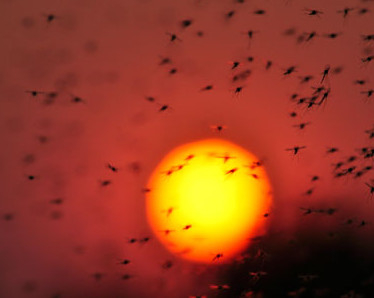
|
Archived NIMBioS Working Group
Climate Change and Vector-borne Diseases (VBDs)
Topic: Climate Change and Vector-borne Diseases (VBDs)
Meeting dates: December 3-5, 2013; June 23-25, 2014; June 1-3, 2015; December 15-17, 2015
Organizers:
Nina Fefferman, Ecology, Evolution, and Natural Resources, Rutgers Univ., New Brunswick, NJ
Abba Gumel, Mathematical and Statistical Sciences, Arizona State Univ.
Richard Ostfeld, Ecology, Cary Institute for Ecosystem Studies, Millbrook, NY
Objectives: Vector-borne diseases (VBDs), such as malaria, dengue fever, Lyme disease, West Nile virus, yellow fever and leishmaniasis, continue to pose major public health and socio-economic burdens in many regions of the world (notably the tropical and sub-tropical regions). For example, malaria, which is endemic in over 100 countries (representing nearly 40% of the world's population), accounts for about 300 million cases and over a million fatalities annually (mostly among children under the age of five). Owing to climate change (CC), and increased mobility of humans, VBDs have started making incursions into non-endemic regions (such as the incursion of West Nile virus into North America in 1999).
Climatic factors, such as temperature, humidity, rainfall and vapor pressure, are known to significantly affect the incidence of VBDs. Although mathematical modeling has been extensively used to gain insight into the transmission dynamics of VBDs, the resulting models only rarely incorporate the effect of CC. The purpose of this Working Group is to bring together a cross-disciplinary team of relevant experts, notably modelers, ecologists, and epidemiologists, to study the impact of CC on the spread of VBDs. The short-term objective of the Working Group is to develop a new and realistic modeling framework for studying the effects of CC on the transmission dynamics and control of VBDs. Although the emphasis will be on the two most important VBDs, malaria and dengue fever, the framework will be robust enough to be applicable to other VBDs, such as Lyme disease and West Nile virus. The long-term objective is to contribute to the concerted global effort to find effective ways to combat the spread of VBDs in animal and human populations.
The Working Group is in line with the thematic program of the global mathematical sciences community on Mathematics of Planet Earth (MPE 2013).
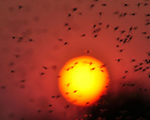
Meeting Summaries
| Mtg # | Dates | Agenda | Summary | Photo | Evaluation |
|---|---|---|---|---|---|
| 1 | Dec 3-5, 2013 | - | Link | Link | |
| 2 | Jun 23-25, 2014 | Link | Link | ||
| 3 | Jun 1-3, 2015 | Link | Link | ||
| 4 | Dec 15-17, 2015 | Link | Link |
Meeting 1 Summary. The group started with discussing mechanisms and features that could affect infectious disease dynamics for vector-borne infections, including pathogen/hosts interactions, pathogen life cycles, ecological features, and climate variability. One subgroup is concentrating on modeling many of these mechanisms in malaria spread in Africa. Another issue is to decide if one can predict the entomological inoculation rate (EIR) by temperature. Representing vector biology features, EIR may be a good risk metric for certain climate effects. One subgroup will use datasets from Africa to better understand variability in EIR values (e.g., vector species, local adaptation, etc). The whole group is working on a review article on "Climate, environmental and socio-economic change: weighing up the balance in vector-borne disease transmission" for a special issue of the Philosophical Transactions of the Royal Society B on "Climate change and vector-borne diseases of humans."
Meeting 2 Summary. The group continues to investigate mechanisms of influence that climate driven changes might have on infectious disease dynamics for vector-borne infections. A subgroup has formulated a basic SEIR human-mosquito interaction model (with stage structure for the mosquito population) and discussed the various temperature-dependent mosquito-related parameters and agreed to use the data from Kakamega Kenya to determine the functional forms of these parameters. This subgroup is considering the use of the wet bulb global temperature, a composite temperature which incorporates the effect of humidity in the model. Another subgroup is describing why we should be more concerned with invasion by chikungunya virus than by malaria parasites in the United States as the climate changes.
Meeting 3 Summary. The third meeting of the working group on the impacts of climate change on vector-borne diseases was focused on developing models that incorporated cutting edge advances in the understanding of the impact of local weather on mosquito ecology into mathematical models of malarial dynamics under weather conditions likely to be affected by climate change. The working group developed one baseline model, then worked to produce two extension models: one to explore the impact of vector population-based control measures and one to incorporate different behavioral types of mosquitos. The group discussed available data sources and identified both a set of immediate and a set of long-term questions for analysis from the models. The group then planned the series of papers that would come from investigation of these questions. The group also discussed progress on the projects from the previous meeting, including the content of three papers published in a special issue on climate change and vector-borne diseases in the journal, Phil. Trans. R. Soc. B, edited by group member (P. Parham). The group briefly discussed continuing efforts among the group members for ongoing projects that did not require in-person discussion during this meeting and made plans for conference calls and email exchanges to ensure continued progress. Lastly, the group discussed potential avenues for future collaborations and meetings involving a broader set of participants.
Meeting 4 Summary. During this final meeting, members of the working group discussed the research progress made since the last meeting, including discussion on some of the recent research papers published by the group members. Expository research talks were given on a number of pertinent issues, such as the challenges associated with incorporating air and water temperature in climate-driven mechanistic models for VBDs, the impact of climate change on the concerted effort to curb the spread of leishmaniasis in India and Brazil and the downscaling of global climate models. A significant portion of the meeting was dedicated to the challenges associated with the determination of realistic values of the parameters of the mechanistic models being used to study malaria transmission in populations. The group plans to write short reports on the challenges of modeling and incorporating air versus water temperature in climate-driven models and the disparity in parameter values for mechanistic models for malaria transmission available in the literature, tracing back to the original sources of these values.
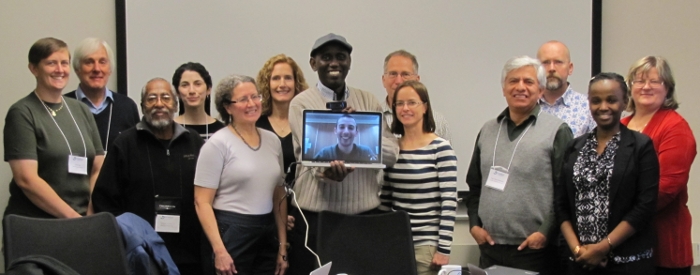 |
| Meeting 1 participants: (Back row, L to R) Paul Ready, Nina Fefferman, Katherine Evans, Richard Ostfeld, Matt Thomas, Elena Naumova. (Front row, L to R) Holy Gaff, Ronald Mickens, Suzanne Lenhart, Abba Gumel, Paul Parham (on laptop), Shannon LaDeau, Jorge Velasco-Hernandez, Folashade Agusto. |
 |
| Meeting 2 participants: (L to R) Huaiping Zhu, Nina Fefferman, Richard Ostfeld, Ronald Mickens, Moetasim Ashfaq, Shannon LaDeau, Katherine Evans, Folashade Agusto, Abba Gumel, Suzanne Lenhart, Holy Gaff. |
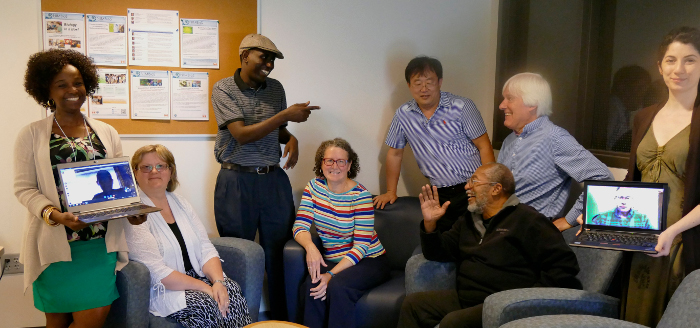 |
| Meeting 3 participants: (L to R) Folashade Agusto, Paul Parham (on laptop), Elena Naumova, Abba Gumel, Suzanne Lenhart, Huaiping Zhu, Ronald Mickens, Paul Ready, Richard Ostfeld (on laptop), Nina Fefferman. |
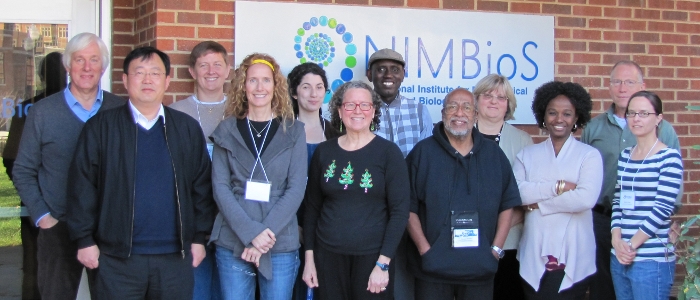 |
| Meeting 4 participants (L to R): Paul Ready, Huaiping Zhu, Holy Gaff, Katherine Evans, Nina Fefferman, Suzanne Lenhart, Abba Gumel, Ronald Mickens, Elena Naumova, Fola Agusto, Richard Ostfeld, Shannon LaDeau. |
NIMBioS Working Groups are chosen to focus on major scientific questions at the interface between biology and mathematics. NIMBioS is particularly interested in questions that integrate diverse fields, require synthesis at multiple scales, and/or make use of or require development of new mathematical/computational approaches. NIMBioS Working Groups are relatively small (up to 10 participants), focus on a well-defined topic, and have well-defined goals and metrics of success. Working Groups will meet up to 3 times over a two-year period, with each meeting lasting up to 2.5 days.
A goal of NIMBioS is to enhance the cadre of researchers capable of interdisciplinary efforts across mathematics and biology. As part of this goal, NIMBioS is committed to promoting diversity in all its activities. Diversity is considered in all its aspects, social and scientific, including gender, ethnicity, scientific field, career stage, geography and type of home institution. Questions regarding diversity issues should be directed to diversity@nimbios.org. You can read more about our Diversity Plan on our NIMBioS Policies web page. The NIMBioS building is fully handicapped accessible.
NIMBioS
1122 Volunteer Blvd., Suite 106
University of Tennessee
Knoxville,
TN 37996-3410
PH: (865) 974-9334
FAX: (865) 974-9461
Contact NIMBioS


